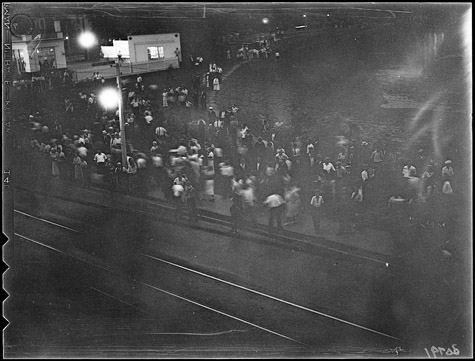 | ||
The Christie Pits riot occurred on 16 August 1933 at the Christie Pits (Willowvale Park) playground in Toronto, Ontario. The riot can be understood in the context of the Great Depression, anti-semitism, Swastika clubs and parades and resentment of "foreigners" in Toronto, and the rise of Hitler and the Nazis in Germany in 1933.
Contents
Background
The riot occurred in the midst of the Great Depression and six months after Adolf Hitler took power in Germany. The Toronto papers, including the Telegram and the Toronto Star, as well as the Yiddish journal, Der Yiddisher Zhurnal, reported on how Jews were being dismissed as lawyers, professors, teachers, etc. in Germany, as well as incidents of violence against them. Thus to Jews, the swastika represented degradation and physical violence against Jews, and was inflammatory.
At that time, the Jewish community in Toronto was predominantly poor and working-class. They were also the subject of discrimination, and were excluded from summer resorts outside of the city. Jewish families and youths in particular would therefore cool off during the hot summer months by staying in town and going to the predominantly Anglo Beaches area in order to swim. This resulted in complaints and resentment from some local residents. Some of the locals formed "Swastika Clubs", which openly displayed the Nazi symbol to express their displeasure and make Jews feel unwanted. The leaders of the Swastika Club initially insisted that the swastika had nothing to do with Hitler. They said they merely wanted to keep the Beach clean. After a meeting with Jewish leaders backed by City officials, the Swastika club agreed to drop its symbol and its name. At that point, several of the members joined the Swastika Association of Canada that was much more open about its links to Hitler.
The riot
The riot, which lasted six hours, broke out after a quarter-final baseball game at Christie Pits between two local clubs: Harbord Playground, predominantly Jewish, with some Italians, and St. Peter's, a baseball team sponsored by a Catholic church at Bathurst and Bloor.
The night of the riot was the second game between Harbord and St. Peter's. Two nights earlier, at the first game of the series, a swastika had been displayed. Police were warned in writing that there could be trouble at the second game, but those warnings were ignored. After the final out of the second game, Pit Gang members displayed a blanket with a large swastika painted on it. A number of Jewish boys and young men who had heard about the previous Swastika incident rushed the Swastika sign to destroy it, supporters of both sides (including Italians who supported the Jews) from the surrounding area joined in, and a fight started.
The Toronto Daily Star described the event the next day:
Aftermath
No one was killed in the riot. There was criticism of the police for not being ready to intervene, as they had been during previous potential problems in the Beach area. After the riot, Mayor Stewart warned against displaying the swastika and there were no further riots.
The riot revealed the xenophobic attitudes toward Jews and other non-Anglo immigrants among some Anglo Canadians. Jews represented the largest minority in Toronto in 1933 and were thus a target of xenophobic residents. The event had some parallels to the 1875 Jubilee riots, an outbreak of Protestant-Catholic sectarian violence in Toronto and Anti-Greek Riots previously occurred in the city in 1918.
Legacy
In August 2008, a Heritage Toronto plaque was presented to commemorate the 75th anniversary of the riot.
